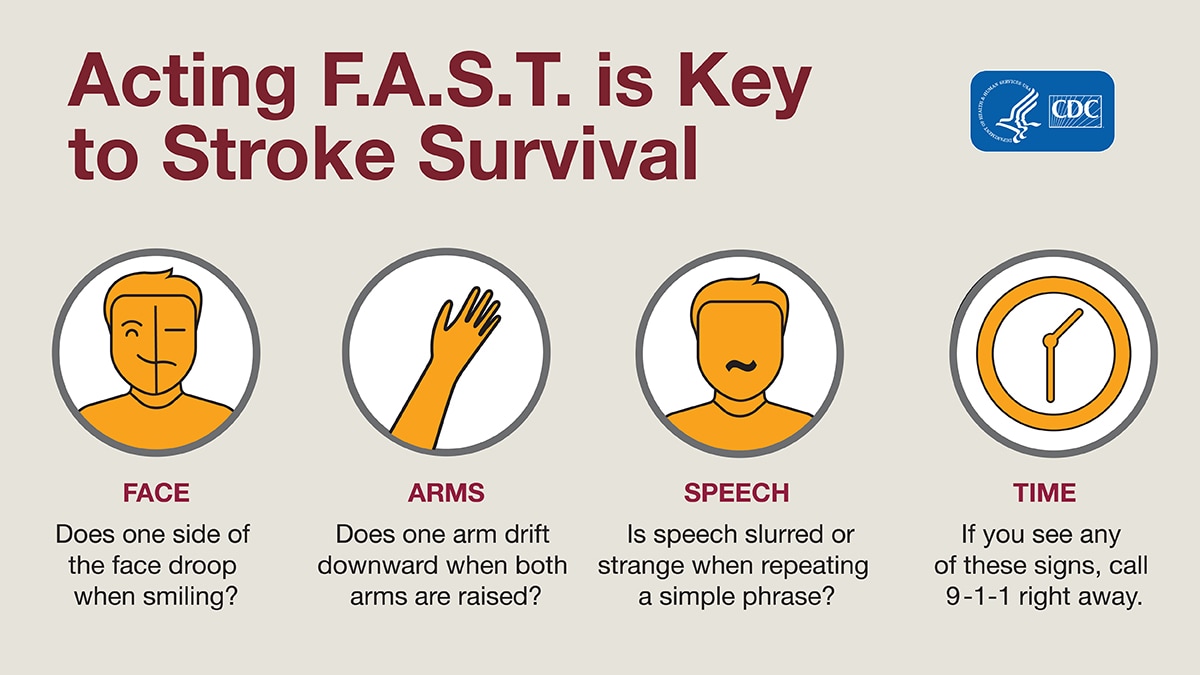Key points
- Stroke is a leading cause of death for women.
- High blood pressure, also called hypertension, is a main risk factor for stroke.

Overview
Stroke is a leading cause of death for women.1 In the United States, 1 in 5 women between the ages of 55 and 75 will have a stroke.2
Surprised? You're not alone. Many women do not know their risk of having a stroke.
These facts are alarming, but there is good news: 4 in 5 strokes are preventable.3 That's why it's important to know your risk for stroke and take action to protect your health. And you can learn more about how CDC and its partners are leading programs to help women reduce their risk for stroke.
What is stroke?
A stroke, sometimes called a brain attack, happens when blood flow to an area of the brain is blocked or when a blood vessel in the brain bursts. Blood carries oxygen to cells in the body. When brain cells are starved of blood, they die.
Stroke is a medical emergency. It's important to act F.A.S.T. and get treatment as soon as possible (see sidebar). Call 9-1-1 right away if you or someone you are with shows any signs of having a stroke.
Some treatments for stroke work only if given within the first 3 hours after symptoms start. A delay in treatment increases the risk of permanent brain damage or death.

Risk factors
High blood pressure, also called hypertension, is a main risk factor for stroke.
More than 2 in 5 women in the United States have blood pressure greater than or equal to 130/80 mm Hg or are taking medicine to control their blood pressure.4 Only about 1 in 4 of them have their blood pressure controlled to les than 130/80 mm Hg.4
Stroke risk increases with age. Because women generally live longer than men, more women have strokes over their lifetimes.
Women also have unique risk factors for stroke, including:
At-risk populations
Why are African American women at higher risk for stroke?
Stroke is a leading cause of death among African American women, who are more likely to die from a stroke than non-Hispanic White women or Hispanic women in the United States.7 African American people have the highest rate of death due to stroke among all racial and ethnic groups. 7
- Almost 3 in 5 African American women are diagnosed with high blood pressure (greater than or equal to 130/80 mm Hg). This is a much higher proportion than White women (almost 2 in 5).8
- African American women are diagnosed with higher rates of obesity (nearly 3 in 5) and diabetes (more than 1 in 8), conditions that increase the risk for stroke, than White women.8910
- US adults consume more than the recommended amount of salt or sodium, which raises blood pressure and increases the risk for stroke.
- Sickle cell disease, a common genetic disorder in African Americans, can lead to a stroke. About 1 in 365 African American babies are born with sickle cell disease.11
- Smoking greatly increases stroke risk. About 1 in 8 African American women smoke.9
Why are Hispanic women at risk for stroke?
Stroke is the fourth leading cause of death for Hispanic women in the United States.1
- High blood pressure is one of the main risk factors for a stroke. More than 1 in 3 Hispanic women have blood pressure above 130/90 mm Hg.8
- People with diabetes are at higher risk for stroke. More than 1 in 9 Hispanic women have diabetes—and many don't know they have it.10 Among Hispanic adults, diabetes is most common in people of Mexican and Puerto Rican ancestry.10
- Obesity increases the risk for stroke. About half of Hispanic women have obesity.12
Prevention
Most strokes can be prevented by keeping medical conditions under control and making healthy lifestyle changes.
Know your ABCS of heart and brain health
- Aspirin: Aspirin may help reduce your risk for stroke by preventing blood clots. You should check with your doctor before taking aspirin to make sure it is right for you.
- Blood pressure: Control your blood pressure with healthy lifestyle changes (see below) and take your blood pressure medicines as directed.
- Cholesterol: Manage your cholesterol with healthy lifestyle changes and take your medicine as directed.
- Smoking: Don't start smoking. If you do smoke, learn how to quit.
Make lifestyle changes
- Eat healthy. Choose healthy foods most of the time. Eat foods with less salt, or sodium, to lower your blood pressure, and that are rich in fiber and whole grains to manage your cholesterol. Learn more about healthy eating basics from ChooseMyPlate.gov, as well as small steps you can take to boost your healthy eating habits from the "Live to the Beat" campaign.
- Get regular physical activity. Regular physical activity helps you reach and maintain a healthy weight and keeps your heart and blood vessels healthier. Find inspiration and tips for getting regular physical activity from the "Live to the Beat" campaign.
Work with your health care team
- Talk to your doctor about your chances of having a stroke, including your age and whether anyone in your family has had a stroke. Learn how to find the right doctor for you from the "Live to the Beat" campaign and how to make small steps toward heart-healthy living from the "Start Small. Live Big." campaign.
- Get other health conditions under control, such as diabetes or heart disease.
What CDC is doing
CDC and its partners are leading national initiatives and programs to reduce rates of death and disability caused by stroke and to help women live longer, healthier lives.
- CDC's Division for Heart Disease and Stroke Prevention (DHDSP) provides resources to all 50 states to address heart disease and stroke, as well as helps lead or support the following:
- The WISEWOMAN program provides low-income, underinsured, or uninsured women with chronic disease risk factor screening, lifestyle programs, and referral services in an effort to prevent heart disease and strokes.
- The Paul Coverdell National Acute Stroke Program funds states to reduce death and disabilities from stroke.
- The Million Hearts® initiative, which is co-led by CDC and the Centers for Medicare & Medicaid Services, works with other federal agencies and private-sector partners to raise awareness about heart disease and stroke and prevent heart attacks and strokes.
Resources
CDC
Million Hearts® and CDC Foundation
- "Start Small. Live Big." This campaign encourages adults 55 and older, to get back on track with the small steps—like scheduling their medical appointments, getting active, and eating healthy—so they can get back to living big.
- "Live to the Beat." This campaign focuses on empowering Black adults to pursue heart-healthy lifestyles on their own terms—to find what works best individually and consistently—as they live to their own beat.
Other Organizations
- National, Heart, Lung, and Blood Institute: What Is a Stroke?
- Heart Health and Pregnancy
- National Institute of Neurological Disorders and Stroke (NINDS): Stroke Information Page
- NINDS Know Stroke Campaign
- NINDS Know Stroke Campaign Spanish Toolkit
- National Center for Health Statistics. Multiple cause of death 2018–2022 on CDC WONDER Database. Accessed May 3, 2024.
- Seshadri S, Beiser A, Kelly-Hayes M, et al. The lifetime risk of stroke: estimates from the Framingham Study. Stroke. 2006;37(2):345–350.
- Centers for Disease Control and Prevention. Vital signs: preventing stroke deaths. Accessed May 4, 2022.
- Centers for Disease Control and Prevention. Hypertension cascade: hypertension prevalence, treatment and control estimates among US adults aged 18 and older applying the criteria from the American College of Cardiology and American Heart Association's 2017 Hypertension Guideline—NHANES 2017–2020. Published 2023. Accessed May 3, 2024.
- National Center for Health Statistics. FastStats: women's health. Accessed May 4, 2022.
- National Institute of Mental Health. Women and mental health. Accessed May 4, 2022.
- Tsao CW, Aday AW, Almarzooq ZI, et al. Heart disease and stroke statistics—2023 update: a report from the American Heart Association. Circulation. 2023;147:e93–e621.
- Ostchega Y, Fryar CD, Nwankwo T, Nguyen DT. Hypertension prevalence among adults aged 18 and over: United States, 2017–2018. NCHS Data Brief. 2020;(364):1–8.
- National Center for Health Statistics. FastStats: health of Black or African American non-Hispanic population. Accessed May 4, 2022.
- Centers for Disease Control and Prevention. National Diabetes Statistics Report: estimates of diabetes and its burden in the United States. Accessed May 4, 2022.
- National Heart, Lung, and Blood Institute. Sickle cell disease: causes and risk factors. Accessed May 4, 2022.
- National Center for Health Statistics. FastStats: health of Hispanic or Latino population. Accessed May 4, 2022.
